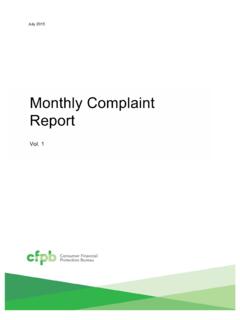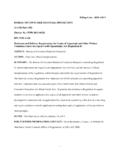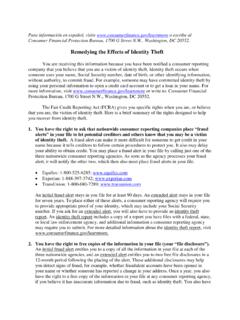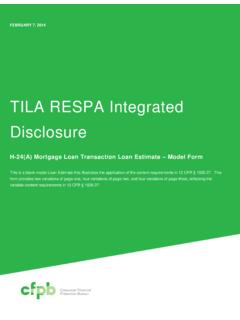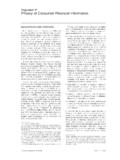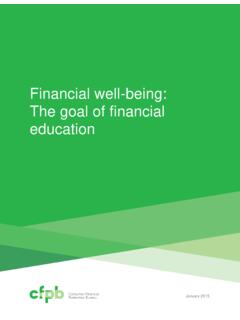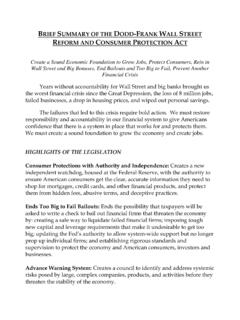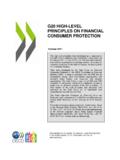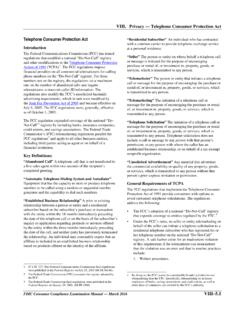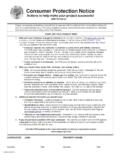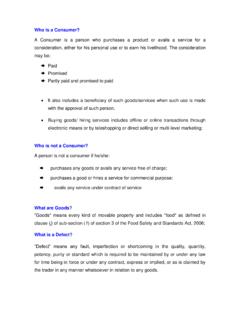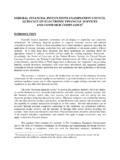Transcription of The Consumer Credit Card Market
1 1 BUREAU OF Consumer financial protection Consumer Credit card Market REPORT BUREAU OF Consumer financial protection | AUGUST 2019 The Consumer Credit card Market 2 BUREAU OF Consumer financial protection Consumer Credit card Market REPORT Message from Kathleen L. Kraninger Director of the Bureau of Consumer financial protection Credit cards are one of the most commonly-held and widely-used financial products in America. At last count, nearly 170 million Americans hold Credit cards, many of them carrying more than one. Some consumers use these strictly as payment devices, paying their balances in full each month, while others use them as a source of Credit and carry a balance from month to month. The Credit card Accountability Responsibility and Disclosure Act ( card Act) requires the Bureau to prepare a biennial report to Congress regarding the Consumer Credit card Market . This is the Bureau s fourth report, and details findings regarding, among other things, the cost and availability of Credit and innovations in the Credit card marketplace.
2 The report also emphasizes that with the passage of time, it is becoming increasingly difficult to correlate the card Act with specific effects in the marketplace that have occurred since the issuance of the Bureau s last biennial report, and, even more so, to demonstrate a causal relationship between the card Act and those effects. Accordingly, while the Bureau will continue to report on the card Act s effects where appropriate and feasible, the Bureau anticipates future reports will focus more on overall conditions in the Credit card Market . Evidence-based research like this is one way in which the Bureau discharges its statutory duty to monitor for risks to consumers in the offering or provision of Consumer financial products and services. It is my hope that the publication of this report with the latest data on this important Market will be useful to consumers, providers of Credit card products, and policymakers. Sincerely, 3 BUREAU OF Consumer financial protection Consumer Credit card Market REPORT Kathleen L.
3 Kraninger 4 BUREAU OF Consumer financial protection Consumer Credit card Market REPORT Table of contents Message from Kathleen L. Kraninger .. 2 Table of 4 Executive summary .. 6 1. Introduction .. 15 Review mandate ..15 Report scope .. 16 Methodology .. 17 2. Use of Credit .. 26 Market -level metrics .. 26 Consumer use metrics .. 30 Delinquency and charge-off .. 39 Usage of digital servicing .. 47 3. Cost of 55 Total cost of Credit .. 55 Interest charged .. 57 Fees assessed .. 61 4. Availability of Credit .. 72 New accounts .. 72 Existing accounts .. 90 5. Practices of Credit card issuers .. 99 Rewards .. 99 5 BUREAU OF Consumer financial protection Consumer Credit card Market REPORT Balance 106 Cash advances .. 109 6. Scholarship on card Act effects .. 113 direct effects .. 116 Overall 127 7. Credit card debt collection .. 137 Debt collection markets .. 137 Collections prior to charge-off.
4 140 Recovery following charge-off .. 152 Special topics in Credit card collections .. 166 8. Innovation .. 170 Account servicing innovation .. 171 Innovation at the physical Risk management innovation .. 182 Appendix A: Supporting figures .. 191 6 BUREAU OF Consumer financial protection Consumer Credit card Market REPORT Executive summary Credit cards are central to the financial lives of nearly 170 million American consumers. Over the last few years, the Credit card Market , the largest Consumer lending Market measured by number of users, has continued to grow in almost all dimensions and measures. Market conditions remain stable, in large part because of low unemployment, modest wage growth, and high Consumer confidence in the past two years. Credit cardholders continue to use their cards to facilitate transactions, smooth consumption, and earn rewards, all with the added security of stringent limitations on liability.
5 Consumer satisfaction with Credit cards remains high,11 Power reported that in 2018 c onsumer satisfaction with Credit cards remained near its record high. See Press Release, Power, Credit card Rewards Battle Continues as Customers Seek Better Programs, Power Finds (Aug. 16, 2018), available at while consumers debt service burden remains near its lowest level recorded in more than a decade. Late payment and default rates have risen modestly over this period but remain below pre-recession levels. In general, Credit card issuers continue to generate profitable returns consistent with historical levels. Innovation has continued to reshape the Market , for both users and providers. New providers, including large and small financial institutions as well as startup and mainstream technology companies have entered or are in the process of entering the Market with competing products, features, and new ways of issuing Credit Reference in this report to any specific commercial product, service, firm, or corporation name is for the information and convenience of the public, and does not constitute endorsement or recommendation by the Bureau.
6 The Credit card Accountability Responsibility and Disclosure Act ( card Act or Act)3 was enacted ten years ago. Since its passage, researchers, including the CFPB, have studied the 3 Pub. L. No. 111-24, 123 Stat. 1734 (2009). 7 BUREAU OF Consumer financial protection Consumer Credit card Market REPORT effects of the card Act on the cost and availability of Credit to consumers. This report discusses that research. However, the Bureau also emphasizes that with the passage of time, it is becoming increasingly difficult to correlate the card Act with specific effects in the marketplace that have occurred since the issuance of the Bureau s most recent biennial report, and, even more so, to demonstrate a causal relationship between the card Act and those effects. Accordingly, while the Bureau will continue to report on the card Act s effects where appropriate and feasible, the Bureau anticipates that future reports will focus more on overall conditions in the Credit card Market .
7 This executive summary provides some background for the report, then summarizes key findings. BACKGROUND In 2009, Congress passed the card The Act superseded a number of earlier regulations that had been finalized, but had not yet become effective, by the Office of Thrift Supervision (OTS), the National Credit Union Administration (NCUA), and the Board of Governors of the Federal Reserve System. Those earlier rules were announced in December of 2008 and published in the Federal Register the following month. See 74 Fed. Reg. 5244 (Jan. 29, 2009); 74 Fed. Reg. 5498 (Jan. 29, 2009). The rules were withdrawn in light of the card Act. See 75 Fed. Reg. 7657, 75 Fed. Reg. 7925 (Feb. 22, 2010). 5 See Bureau of Consumer Fin. Prot., card Act Report, (Oct. 1, 2013) (2013 Report), The Act made substantial changes to the Credit card Market . The card Act mandated new disclosures and underwriting standards, curbed certain fees, and restricted interest rate increases on existing balances.
8 Among the card Act s many provisions was a requirement that the Board of Governors of the Federal Reserve System (Board) report every two years on the state of the Consumer Credit card Market . With the passage of the Dodd-Frank Wall Street Reform and Consumer protection Act (Dodd-Frank Act) in 2010, that requirement passed to the Bureau of Consumer financial protection (Bureau) alongside broader responsibility for administering most of the card Act s provisions. This is the fourth report published pursuant to that obligation, building on prior reports published by the Bureau in 2013, 2015, and ; Bureau of Consumer Fin. Prot., The Consumer Credit card Market , (Dec. 2015)(2015 Report), 8 BUREAU OF Consumer financial protection Consumer Credit card Market REPORT The Bureau s 2013 Report focused on trends in the Credit card marketplace before and after the card Act. Because the implementation of the Act coincided with a period of economic recovery, the effects of the card Act were difficult to discern.
9 The Bureau found that the card Act significantly enhanced transparency for consumers and largely eliminated [o]verlimit fees and repricing actions. 6 The report found that from early 2009 and continuing through February 2010 when many provisions of the Act took effect, the interest rate on Credit card accounts increased. But because back-end fees also decreased across this period the total cost of Credit declined by 194 basis points from Q4 2008 to Q4 2012. 77 The report defined total cost of Credit as the annualized sum of all amounts paid by consumers (including both interest charges and fees) divided by the average of outstanding balances. See id. 8 According to the Bureau s data, total Credit line was $200 billion lower at the end of 2012 than when many provisions of the card Act took effect in February 2010. See id. at 6. The report was not able to conclude how much of that change was attributable to the card Act. The report also noted declines in Credit availability beginning in 2008, prior to the enactment of the card Act, but after the onset of the Great Recession.
10 Certain metrics, such as total Credit line, continued to decrease after the implementation of card Act provisions, with their effect disproportionately concentrated in subprime With some exceptions, the report was not able to conclude the extent to which such change resulted from the Act. However, the report did find evidence that suggests the card Act had a discernible impact on Credit availability in three respects a substantial decrease in the number of Credit card accounts originated among students and other consumers under the age of 21, a small but discernible percentage of applicants deemed otherwise creditworthy were declined as a result of insufficient income to satisfy the card Act s ; Bureau of Consumer Fin. Prot., The Consumer Credit card Market , (Dec. 2017) (2017 Report), The Bureau also held a conference in 2011 in which numerous Market stakeholders contributed information and perspective on developments in the Credit card Market .

